Macaron Tips for Beginners
Making macarons for the first time? Here is what you need to know! Read the post below with the best macaron tips for beginners!
First I will explain the three methods of making macarons, and below you can find 5 Macaron Tips for Beginners!
This is part of a series of posts where I try to educate you and pass along all of the knowledge I’ve acquired over the years after making thousands of batches of macarons.
This post may contain affiliate links. I earn a commission from qualified purchases. Please read our Privacy policy here.
I’ve made a LOT of mistakes on my journey, and I still do, specially if I attempt to experience with a new technique, or with new equipments or ingredients.
It’s all a part of it. I take each mistake as learning, and I suggest you do the same.
There are basically three methods you can use to make macarons: French, Italian, and Swiss. My favorite method for making egg white macarons is the Swiss, and for vegan macarons is the French method.
French method
The most popular method, and also the simplest one, because it requires less steps.
The French method consists of whipping the egg whites with some form of stabilizer such as cream of tartar, until foamy, and then adding the granulated sugar and continuing to whip until the meringue achieves stiff peaks. And then mixing the dry ingredients, almond flour and powdered sugar together with the meringue to make the batter.
The French method is simple and more straight-forward, however it has its downside, which is the fact that this technique doesn’t make the most stable meringue out of the three different methods. So it’s more prone to deflate, break, get over whipped.
Italian method
Italian method is definitely the one with the most steps. My least favorite one.
It requires making a water/sugar syrup, and heating it to a certain temperature, soft ball stage (238ºF-240ºF), while you whip the egg whites to soft peaks. Then, as soon as the syrup reaches this temperature you have to add it to the soft peaks whites, while the mixer is still running, and continue to whip until the meringue achieves stiff peaks, which will also take a while, since now the meringue has to cool down a lot before it reaches the peaks.
And you should also mix some of the egg whites with the powdered sugar and almond flour, forming a paste, which will get folded into the meringue.
As you can see, this method is the most high maintenance one. It requires a candy thermometer, and you have to try your best to achieve the soft peaks of the whites at the same time you achieve the syrup temperature, otherwise the syrup will not be in the perfect temperature if you need to continue to whip the whites, or the whites will not be in the soft peak stage anymore if you need to continue to heat the syrup. It’s just a whole thing.
I don’t recommend this method if you are a beginner. Of course, lots of beginners may have had luck with this method, and it does make the most stable meringue out of all three of them. But that doesn’t mean that you can’t work on perfecting the French or Swiss methods without having to go through all of these steps to make your macarons.
Which brings me to the best method of all (in my opinion of course)
Swiss method
The king of all! The Swiss method is in between the French and the Italian, as in it make a more stable meringue than the French method, but it doesn’t require all the fussy stuff as the Italian does.
To make the Swiss method macarons you will heat the egg whites and sugar over a double boiler, just until the sugar melts, which will take 1 or 2 minutes. And you don’t need a thermometer for this, you just need to touch some of the syrup with your hands, and if you don’t feel any sugar granules, it’s good to go.
Then, the syrup gets transferred to a mixer and whipped until stiff peaks are achieved. Lastly, the dry ingredients get folded in with the stiff meringue.
By far the best method! It has way way less steps than the Italian, it’s more reliable than the French, it’s great for humid climates, I can’t vouch for this method enough. It is the method I recommend for beginners, and it was the first method that made perfect macarons for me.
I do use French method on a couple of my recipes, such as these Coconut Macarons and Guinness Macarons. But all the other ones on my macaron list are made with the Swiss method.
Anyway, continue to read as I have 5 very awesome Macaron Tips for Beginners below!
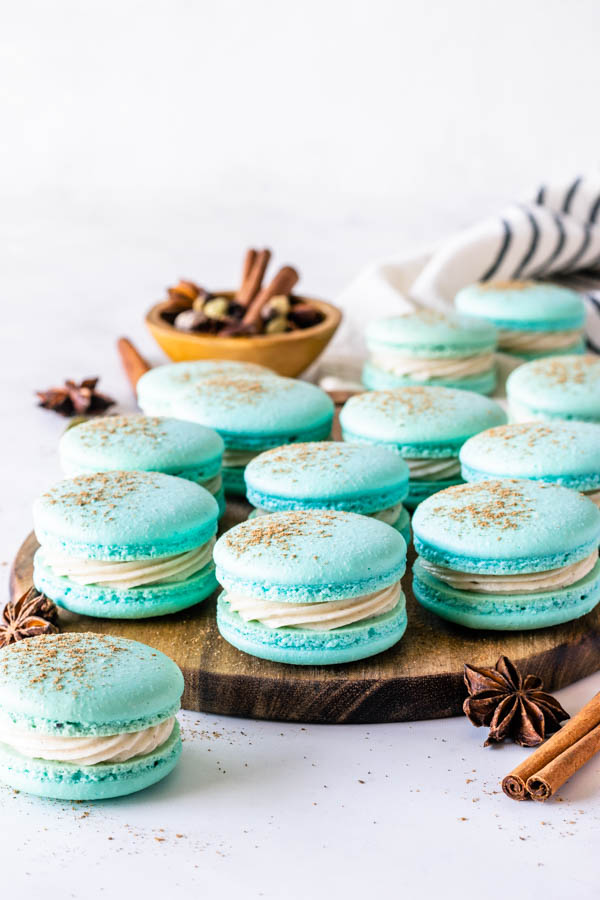
1- Have a learner’s mindset
Ok, I don’t mean to get all motivational on you, but you will need a growth mindset in order to master macarons. Because you WILL make mistakes, you will be puzzled at times wondering what is going wrong. Sometimes you will be so confident thinking you nailed every step of the way, only to open your oven and see cracked macarons! Trust me, it will happen!
My best advice for this is: have a notebook where you register notes, and write down experiments, different resting times, oven temperatures, techniques, ingredient ratios, almond flour brands. Write it all down. It will come in handy when trying to troubleshoot your batches that give you issues.
And understand that you will learn a lot from those mistakes. Refer to my Troubleshooting Guide if you need help. (coming soon)
There is a lot of information out there, lots of fabulous bakers, bloggers and YouTubers who post such valuable tips and share their knowledge. It’s also very helpful to join macaron Facebook groups, they can be very helpful, people in these groups are usually really kind with sharing their knowledge, helping troubleshoot batches, and offering amazing tips and tricks.
Stay learning, researching, improving. Don’t give up.
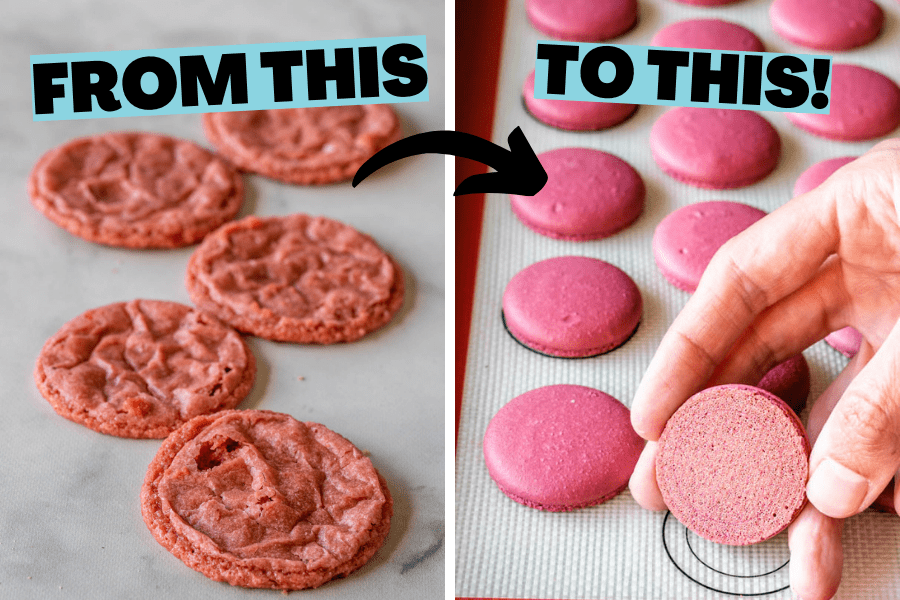
2- Leave out the food coloring
If you are a beginner, leave out the food coloring or any flavoring for that matter.
Keep your macaron shells plain until you master the basics: a nice smooth shape, and cute feet.
Once you have found a recipe and method that resonate with you and give you good results, then you can start adding food coloring and flavoring to the shells.
The reason is very simple, food coloring adds a lot of moisture to the shells, and it will take time for you to find a brand that works well for you, the proper amount you will need to add to achieve the colors you want.
My tips for food coloring are: always use gel or powder food coloring. Liquid food coloring is not recommended. I do know of some macaron bakers who use liquid food coloring, but they have been baking macarons for years and years, they are masters, and they know which brands to use, how the food coloring affects their recipe, and how much to add.
The issue with adding food coloring at the beginning is that it may throw you off when trying to troubleshoot any technique issues you may be having. For example, if you are adding too much food coloring, or the wrong kind of food coloring, your shells may crack in the oven. However, cracked shells may also be a result of under whipped meringue, under rested shells, or high oven temperature. Those are fundamental techniques you need to master, and if you are making one of those mistakes and also using food coloring, it becomes harder to pin point what mistake you are actually making.
Now about the flavoring of the shells, be very careful with this. Adding anything that contains oil will ruin your shells, some flavorings might be oil based, or contain oily ingredients. Also ingredients such as cinnamon, turmeric, will ruin your shells, you don’t want to add a whole lot of them to the shells. But until you are an advanced baker, leave them out, because, again, it will make it harder for you to pin point any technique mistake you might be making.
If you are a beginner, it’s ok to add cocoa powder for Chocolate Macarons, or matcha powder for Matcha Macarons to your shells, as long as you are following a recipe that provides the correct measurements.
Keep it simple. Once you become more comfortable and advanced, then you can begin to spice up your shells.
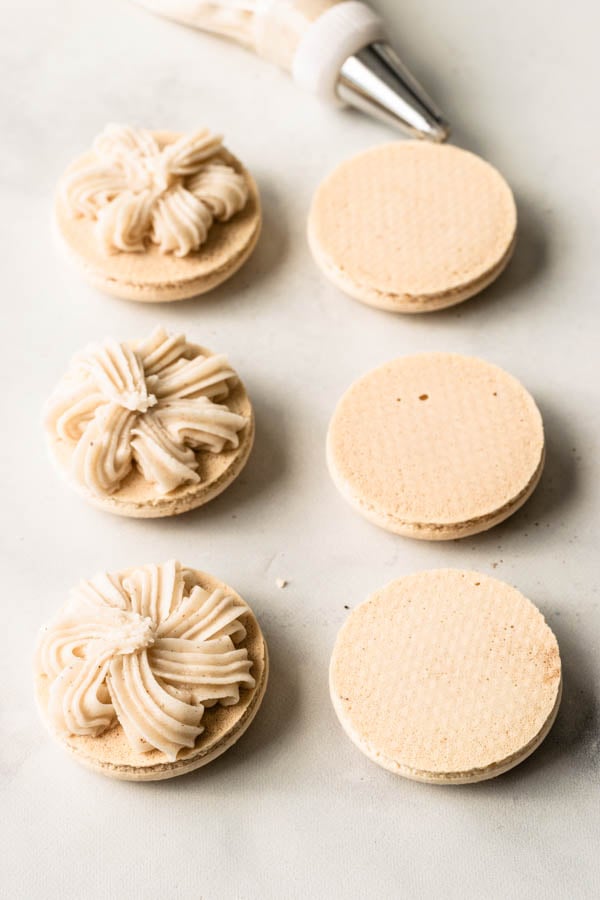
3- Get an oven thermometer
This is probably the most important of the Macaron Tips for Beginners I am offering today, because so many people take it for granted.
The truth is, you shouldn’t even attempt to bake macarons without an oven thermometer.
I am not exaggerating. Read all about the oven in detail on this post.
But please understand how important it is to have an oven thermometer in your oven.
Home ovens (and even professional bakery ovens) are very inaccurate at keeping a stable accurate temperature. Most often, the oven is set to a certain temperature, say 325ºF, but the internal temperature will fluctuate up and down, or spike up.
For example, my oven spikes up the temperature and even when I set it to 325ºF, after some time, the temperature will be 350ºF, which is way too hot and will crack my macarons. Without an oven thermometer I would never be able to know that I have to actually turn the temperature down on the dial.
When making macarons, just a difference of 5 degrees can make for completely different results. Which is why I couldn’t recommend enough that you get an oven thermometer before you even attempt to make macarons.
I usually keep 3 in my oven, so this way I am aware of any hot spots in there also, so I know how to best position the tray in the oven, and if I have to rotate it or not.
Please make sure to read this post about understanding your oven when making macarons.
Get an oven thermometer!
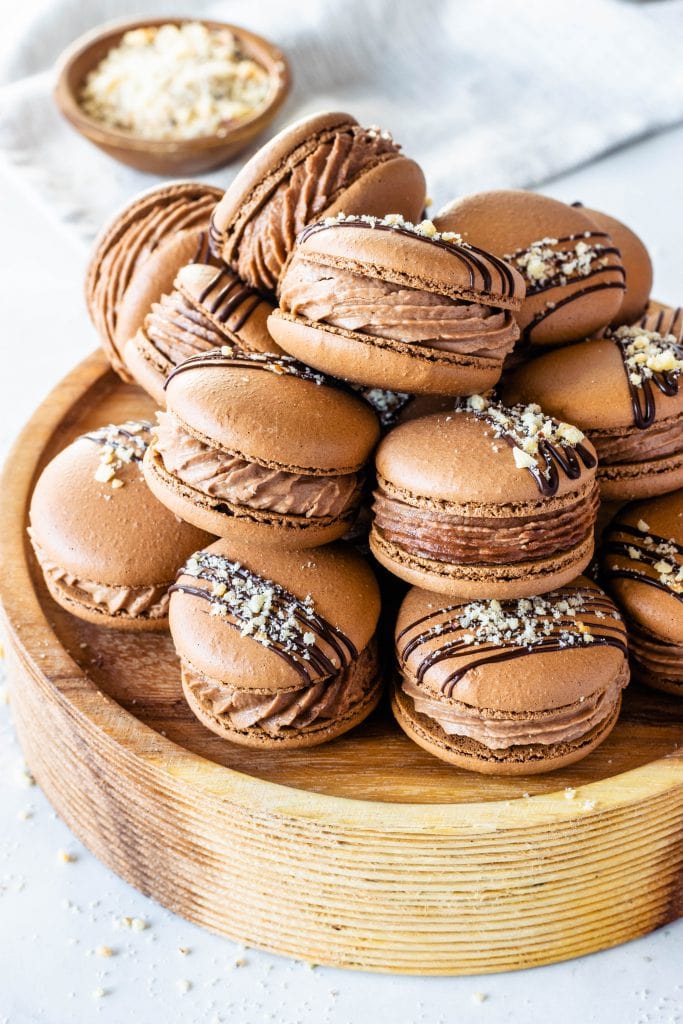
4- Use a scale to weigh the ingredients
I have already said this in previous posts, but I will say it again on these Macaron Tips for Beginners Guide.
It is very important to weigh the ingredients with a scale.
Scales are not very expensive, and will be very useful if you like to bake. And they will be essential for making macarons.
I get this question all the time: can I have the measurements in cups?
And the answer is: sorry but no! Here’s why.
Macarons are finicky enough as they are. There are already so many elements you have to pay attention to, and aspects you have to nail down, that you don’t want to leave much to chance.
The things you have full control over, such as the measurements of the ingredients, should definitely be spot on, because they are easy to get right.
It’s not always easy knowing when to stop mixing the batter, but it is always easy to weigh the ingredients accurately.
Using cups to measure ingredients is definitely not accurate.
This is the scale I use. Now this scale is on the more expensive side, it’s usually around $45 to $50, you can definitely find cheaper ones, however I’ve had mine for over 6 years! So to me that’s worth it, considering I use it a lot.
5- Get acquainted with the terminology
These are some terms you may read around when learning about macarons. Hope this list can help.
Macaronage- the act of folding the dry ingredients (almond flour/ powdered sugar) with the meringue.
Stiff meringue- meringue with peaks shooting straight up, not bending to the side or down.
Resting the macarons- letting the piped batter sit before baking, until it develops a skin and the macarons feel dry to the touch.
Over whipped/ Under whipped meringue- referring to the meringue, when you whip the egg whites with sugar too much, or too little. Under whipped meringue will be soft, with long peaks that bend. Over whipped meringue will be separated, chunky. The perfect meringue is glossy, and the peaks are shooting straight up when you lift up the whisk.
Over folded/ Under folded batter- referring to the macaronage process, after you’ve mixed the dry ingredients (almond flour/ powdered sugar) with the meringue. Over folded batter will be runny, too liquidy. Under folded batter will be stiffer, not flowing off the spatula. The perfect consistency batter will be flowing off the spatula slowly but effortlessly, also known as the figure 8 stage.
Figure 8 stage- when you are able to draw several figure 8s with batter falling off the spatula without the batter breaking up. Usually an indication that the batter is ready.
Drying egg whites- some people crack their eggs and separate the whites from the yolks a couple of days or the night before making macarons, leave in a container with a loose plastic on top, and place the whites in the fridge, in the hopes of letting some water content evaporate from the whites (I don’t do this, but some bakers swear by it, so you may read about it around).
Egg white powder- not the same as meringue powder. Egg White Powder is a special product some people add to their meringue when making macarons, hoping to make the shells fuller. You should add about 4 grams of egg white powder per 100 grams of egg whites, but again, only experiment with this once you are more experienced.
Hollow macarons- macarons that have a space between the top skin and the bottom feet. It can be a big gap, or small holes.
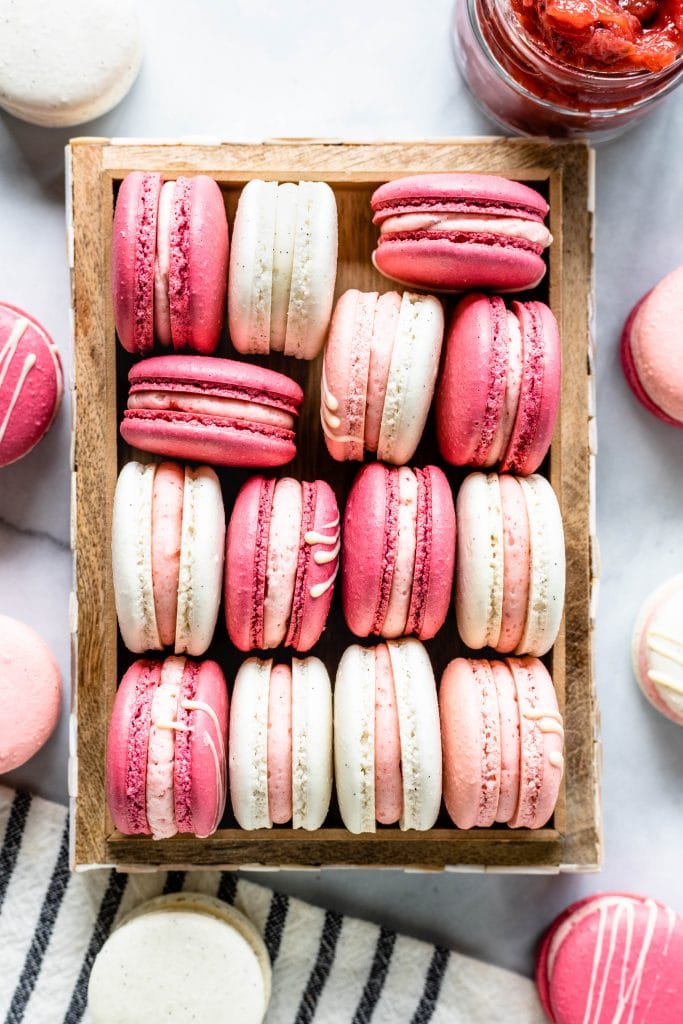
These were some basic tips to get you started! Please read my other posts to find out more information.
- The most important stages of making macarons
- Understanding your oven
- Frequently asked questions
- Troubleshooting Guide
- Hollow Macarons
- Tools I use to make macarons
- The Meringue Stage
- Macaron Tips
- Vegan Macaron Guide
- Vegan Macaron Troubleshooting
Thank you for joining me for today’s Macaron Tips for Beginners! Hope you learned something new and helpful!
Leave a comment below telling me if you have any questions, and if you would like to see any specific macaron content on the blog or on my YouTube channel!




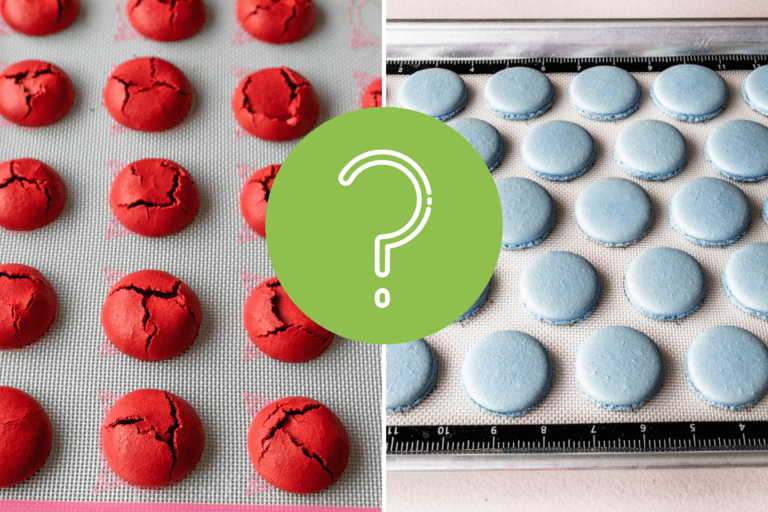
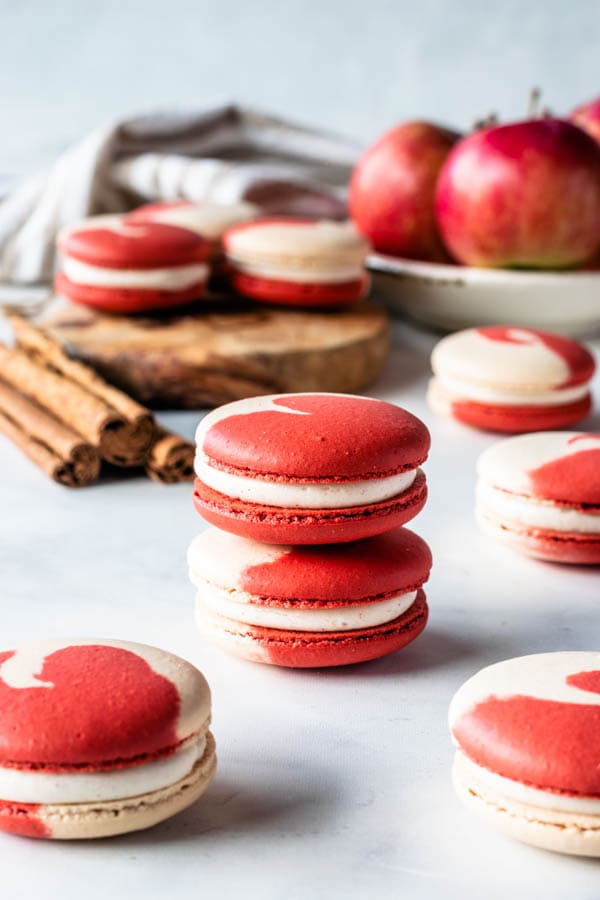
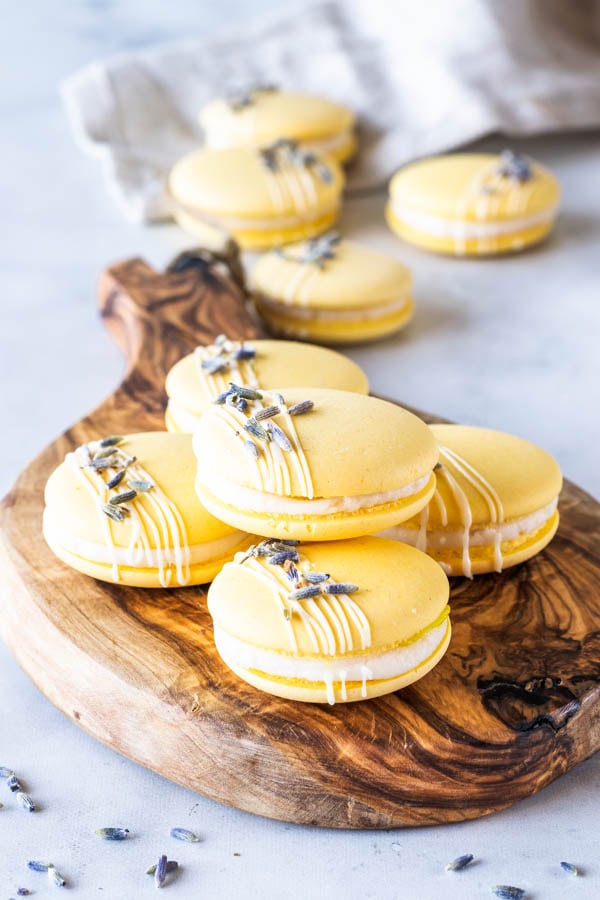

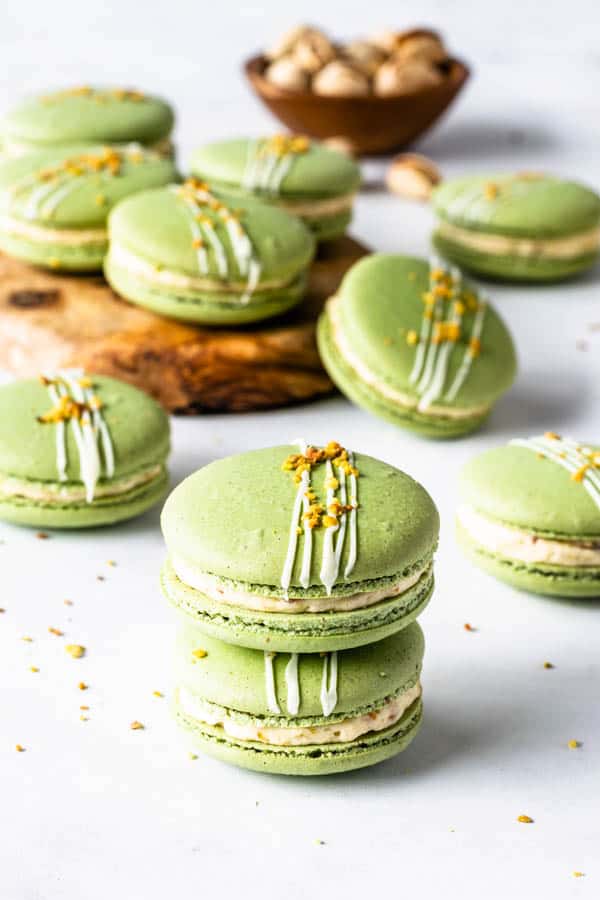
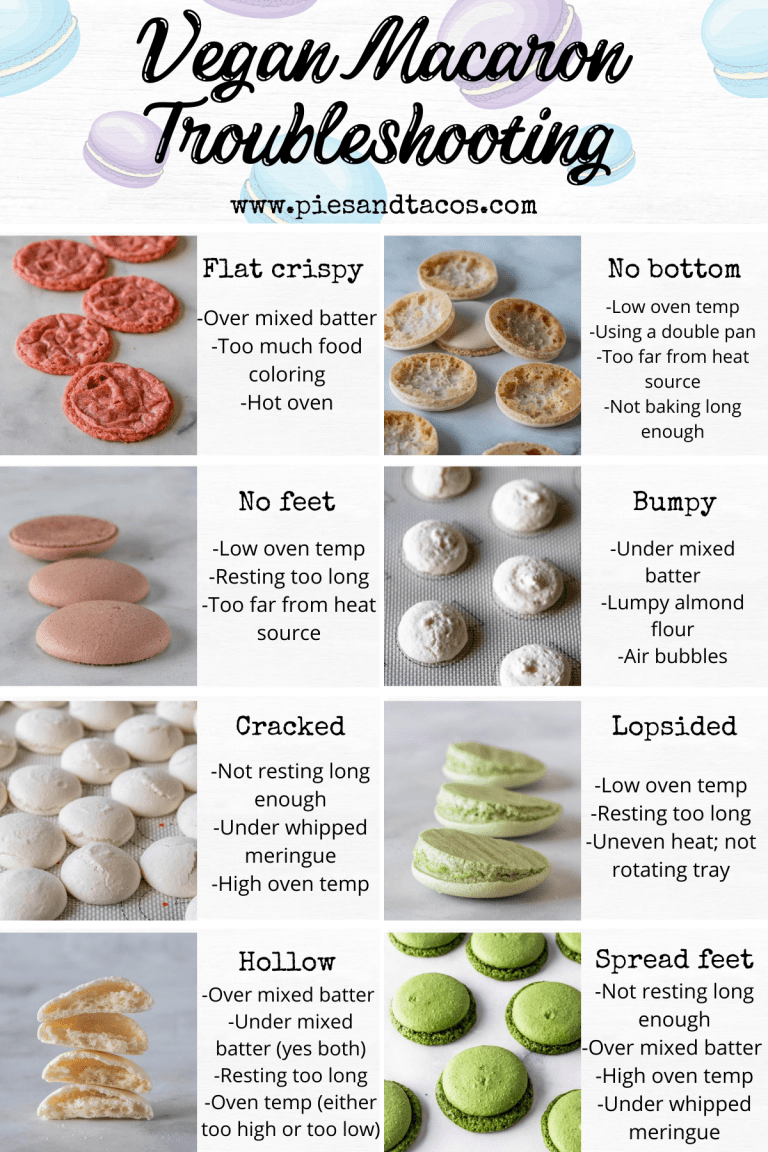
Hi! Im new at this of macarons, I started w french but now Im using swiss method because of humidity, it works best for me. But lately Ive been having some problems w the batter which it seems inpossible to reach the ribbon stage. I saw in one video that the batter should be warm is it true!? Could it be because of that? Or what else could it be!? Thanks in advance!
The batter shouldn’t be warm. I’m not really sure in what context that was said, but not to my knowledge. The batter not reaching the ribbon stage, maybe you could be over whipping the meringue? Sometimes you just have to fold longer, some people may be surprised in the beginning at how long you may have to fold, it can take 5 minutes or more folding sometimes.
I am heartbroken. Today was my first attempt at making Raspberry Macarons (with raspberry powder). All the ingredients were out and measured. I am now ready to proceed. After sifting, inadvertently I added the granulated sugar to the dry ingredients, when I know that the sugar is added in the soft peak stage of the egg whites. I messed up the recipe. What can I do to either rectify the mistake or is there a recipe that I can add those ingredients to?
You cant use that for macarons anymore. Sorry I dont know any recipes that would use these ingredients all combined, and I am not sure how much of each you are using.
Do you use top and bottom heat with fan at 140c or forced air mode
no air mode or fan, my oven is electric.
I’ve tried your snickers macaron’s recipe as well as your cinnamon roll macaron’s recipe. The snickers one’s were my second time ever making them and the cinnamon roll was my third time. Your recipes are amazing! The snickers one’s came out better for me. I tried to use cinnamon on top of the cinnamon roll one’s and ruined the texture. Still yummy though! I can’t wait to try more recipes and use your tips!
Amazing thank you so much Ashley!!!
Can you please tell me where I can find your swiss version of the macaron shell, without any flavoring? Thanks!
sure, this one for example the shell is plain https://www.piesandtacos.comsalted-caramel-macarons/
I can’t get the feet to grow.. the taste is great. Even the shape. No feet.. help
It could be from under mixing the batter, low oven temperature, far from heat source, not resting enough, it could be a myriad of reasons. It’s hard to tell without seeing the macarons. If you can send a picture via instagram dm.
Which macaron flavour are easiest to make the very first time? I have 0% experience in making macarons 🙂
plain macarons with no flavor or color.
Do you have a recipe for those.
Dear Camila,
First I want to thank you for this amazing Blog and sharing all your experience! Your macarons, recipes and photos are really inspiring 😊 i read like everything, and of course am still trying out. I did my 4th batch now and they turned out horribly cracked. 3rd batch was actually ok. What i’d like to ask is, what can i do about when the second tray is resting and logically drying more than the first one? Do you use more then one oven? Or Cover them? Because i think maybe the 4th batch became like this, it was only the second tray. And i also didn’t find any Tips on which heat i should use in the oven, like i tried circulating heat and also two-sided heat. I also tried to Stick a wooden spoon in the oven door while baking so that the humidity could escape but i guess thats nothing good because the heat also is unstable in the oven.. i’m really sorry for writing too much but still hoping maybe you are going to answer 😀 Following your insta and loving everything you do with your lovely macarons, yours sincerely, Maike
I do leave the trays drying without an issue. Sounds like you are having an oven issue here. My oven is a simple electric oven, not convection, so I dont have any of those options to choose from. Youll have to experiment with the settings to see whats best for your oven. if your oven is convection, turn the temperature down and experiment with lower temps. Also make sure to have a couple of oven thermometers in there to be able to check the temperature. If the heat fluctuates too much maybe have your oven checked, or buy a pizza stone and leave it in the oven, it will radiate heat and keep the temperature in the oven somewhat constant, and also pre-heat the oven for a long time this will also help keep a stable temp.
I love your recipes and for the first time since I follow you on Instagram and youtube I’m going to make the creme brule macarons. My only question is, do the egg whites need to be cold or room temperature?
Thank you in advance 🙂
Since you heat it up over the double boiler with the sugar it doesn’t have to be room temperature.
Hi have you ever made macaron with egg white powder instead of liquid egg white?
I havent but I think bake toujours has! Look it up on YouTube.
Hi camilia . I tried so many times Swiss method to make the macarons, it will be perfect from out but it ends in hollow.. I usually keep my eggs in room temperature and while I’m ready to make I crack the egg and get the egg white separate. Is this wrong way. Do I need to crack and separate the egg whites before a day and kept in fridge ? Even I tried to add egg white powder. Then also I had hollow macarons.
I was baking for 150’ , then 148
Can I reduce more ?
Please help me thanks
I dont age my egg whites and it makes minimal difference. I dont think thats the issue. Most likely your meringue. Try whipping less.
I used your plain Swiss meringue macaron recipe — and it worked! I did use aged egg whites, but I followed your recipe to the letter otherwise and I am so pleased. They are beautiful!
So after using 3-4 different recipes from the internet, and making 4 failed batches (the first was just a blobby mess that was totally inedible!), I finally made something I’m proud of.
Thank you, thank you! It has given me the confidence to keep going and experimenting with my macaron journey!
That’s awesome to hear thank you so much!!!
Hi, do you have any tips or recipes on doing small batches of macarons?
make sure the whisk can reach the bottom of the bowl is the only tip I can give. The rest stays all the same. The only issue with making a smaller batch would be the whisk not being able to reach the egg whites to whip the meringue because of the reduced quantity. But if you use a hand mixer, or watch bake toujours last live on Youtube where she is making a small batch and she shows a trick with the whisk where you loosen the whisk in order to make it sort of drop and reach the bottom of the bowl.
Hi Camila,
I baked French one more than a hundred times, they come out hollow normally. A few times they were perfect. Always same method and same ingredients 🤯🤯
A local chef advised probably it is my mood!! Cuz I panic a lot while baking and it is stressful loosing this much ingredient🙈 do you believe in baking mood for macaroon?
Your website is great! I will try Italian tomorrow. I can keep my eyes open on the details you mentioned for days to reach the desired macarons!!
It’s our mood! Hilarious! Sometimes the only explanation
I agree
Can I use a metal mixing bowl? I notice you use a glass one every time
dont use metal bowl for the double boiler part because metal heats up too fast and it’s going to cook the egg whites.
Hi Camille,
Do you have any tips with baking in a gas oven?
I have a small electric oven but it just takes too long with the small amount I can bake, so I’m looking to bake in the gas oven but recently I’ve been having trouble with the electric one I made 2 different batches and they all completely cracked except for 3 that were in the centre 🙁
Thankyou for all the tips and tricks too!
Hi Camille I’m having s as problem with the texture of the macaron it takes on the texture of the almond flour instead of being smooth it also rises and my finished macaron is twice as high as yours!! What am I doing wrong???
well as far as the almond flour goes, you should get a different brand. about the feet, probably due to over whipping the meringue, over mixing the batter, or oven temp being too high.
What kind of baking sheet/pan is best to use for macarons?
aluminum without rims or flip an aluminum tray upside down.
I have always used the French method and while I do make a decent macaron, there are issues. Mainly hollow tops which I finally solved but now I have hollow, too- soft bottoms. I feel my meringue and macronage are on point. They are secure and don’t move when I do the doneness test. Feet are perfect, and after maturing you can’t tell they have hollows. My best guess is that it’s my oven temperature. I’m working on experimenting with different temps and baking times because I want to be able to do the French method perfectly. :-). You know us bakers!!
Howdy! I am new to baking and love trying to make these m-rons:). This may be a silly question but your instructions say it takes about 15-18 minutes to whip egg whites. I follow your recipe to the letter and have the same mixer but it takes about 35-40 minutes to get to stiff peaks. They still turn out wonderful but is this okay or am I doing something incorrectly?
This is 100% ok. For some people can take even less time. Some people tell me they whip theirs in literally 7 minutes. it depends a lot on the eggs, the weather, altitude, etc. If your results are coming out ok then I wouldnt worry
I tried 3 batches (all in the same day) of the French method. All of them failed. First batch I sifted my dry ingredients four times. It was grainy. Next batch I sifted six times, still grainy. Last batch, it was too thick. After discarding the last batter, I almost gave up. But I am a persistent sucker. So, I searched for a better recipe and found this one.I thought, why not. So my fourth batch of the day was your absolutely fantastic recipe! It turned out wonderfully on the first batch!! Thank you so much for explaining differences and pointing me in the right method! I did a happy dance when I saw feet!! Swiss method is definitely my go to recipe!
Yayyyy im so happy you found your way with Swiss, I also love it for this reason, it’s the best!! Welcome to the club!!!